Pepper is one of the indispensable spices in many meals of every family. The spiciness of pepper contributes to creating its own flavor for each dish and stimulates human taste buds. Therefore, many people love to grow pepper plants in pots to make ornamental plants and serve daily meals.
However, some pepper varieties today tend to bear fruit in an upward direction despite the laws of weight. So many gardeners have asked many questions about these peppers. Do you need to worry when the pepper is fruiting and pointing upwards? Do you need to fix this situation? Here are the top 10 peppers that grow upwards that you can refer to and learn more details about.
Peppers That Grow Upwards – What’s The Reason?
In the wild, some types of pepper bear fruit pointing upwards or outwards instead of toward the ground. This phenomenon seems strange because it defies the laws of weight. However, peppers pointing upwards is a perfectly normal phenomenon according to the laws of nature.
Some small pepper varieties will grow upwards because that is their natural state of growth. It is due to the existence of a specific gene that determines whether the peppers grow upwards or droop from the branches.
The upward-facing fruit is also an adaptation of the pepper plant to its natural environment to disperse seeds in the air as the fruit ripens. The eye-catching colors of the upward-facing peppers will also attract insects, bees, and butterflies to pollinate and carry the seeds everywhere.
Peppers with upward-growing fruits tend to resist gravity, so their fruits are often smaller and thinner than other pepper varieties. The pepper varieties that bear fruit facing up have a recessive gene while the varieties that bear fruit that is facing the ground have a dominant gene.
Usually, many people think that the pepper varieties that bear fruit facing up are ornamental peppers. However, some other varieties of pepper are still considered fruit peppers even though their fruit is pointed upwards. The growth habits of pepper plants will not affect the spiciness of the peppers. However, you will find that most naturally upright peppers are the hotter variety. Therefore, you do not need to worry about this phenomenon because it is the natural growth habit of some pepper varieties.
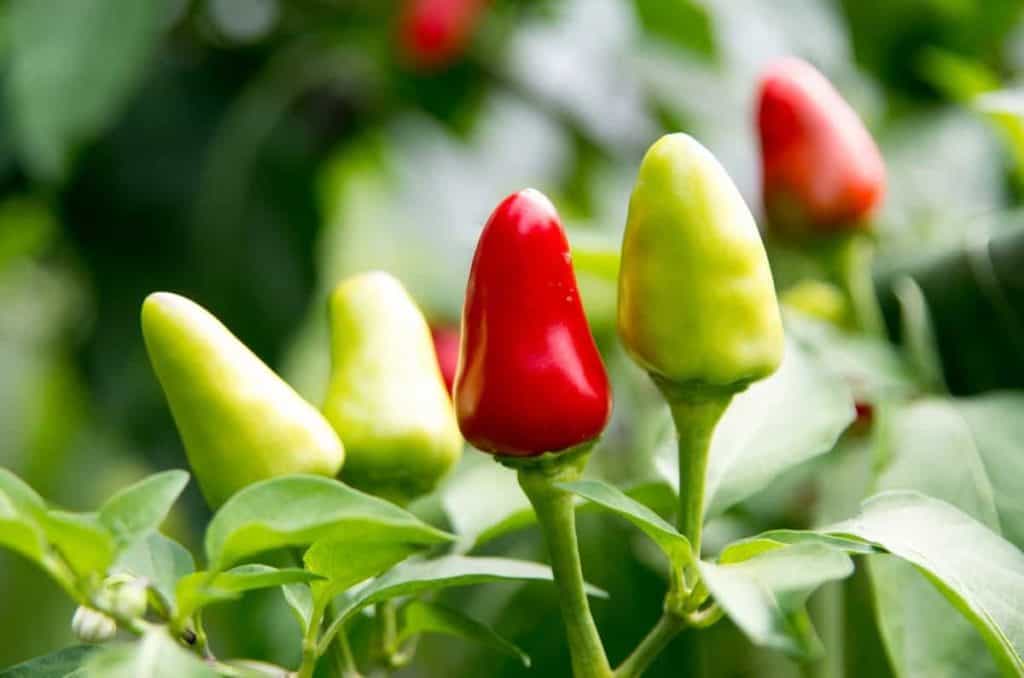
Pros And Cons Of Peppers That Grow Upwards
It is completely normal for chili peppers to grow upwards. It also brings advantages and disadvantages to you during care and harvesting. Here are some advantages and disadvantages of the upward-facing chili.
Advantages Of pepper Facing Upwards
- Easier to harvest: Peppers that grow upwards are easier to see and harvest when they are facing the ground and hiding in the leaves. Especially if you like to harvest green peppers then it will save you a lot of time searching. Because green peppers can often hide in the foliage and you can easily miss them at harvest time.
- Create a more eye-catching look: Many people love to grow pepper plants with fruit that grows upwards in pots for ornamental and indoor decoration. These peppers often have a variety of colors and are eye-catching, so they are very suitable for placing in indoor flower pots. Even small varieties of chili peppers are often grown in pots and hung in windows or offices.
- Home or garden decoration: If you want to decorate your home or garden and still have plenty of hot peppers to use in the kitchen, the peppers that grow upwards are the right choice. You can easily care for the peppers that are facing up like those that are growing down. In particular, they generally produce more fruit when compared to those peppers whose fruit is facing the ground.
Disadvantage Of pepper Facing Upwards
- Broken branches or broken stems: Some large pepper varieties such as bell peppers can cause the branches or stems to break because they cannot bear the excessive weight of the peppers on the stalk. However, most pepper varieties that grow upwards are small and thin. Therefore, they will limit the breakage of branches and trunks.
- More attractive to birds and insects: As you know, chili peppers are often colorful and stand out with colors such as red, yellow, orange, purple, and green… In particular, peppers growing upwards will be more attractive to birds and insects due to their ease of visibility. In particular, birds are not affected by the spiciness of chili peppers, so they can easily eat chili peppers.
Top 10 Peppers That Grow Upwards
The spiciness of the pepper is measured in Scoville heat units (SHU). On this scale, bell peppers score 0 because they are sweet and not spicy. Meanwhile, ghost peppers score between 855,000 and 1,463,000, which is considered extremely spicy. Therefore, pepper grades or ratings are usually rated on a scale of spiciness. Here are 10 varieties of pepper that have the fruit facing up and have their average spiciness compared to Jalapenos pepper (2,500 to 8,000 SHU) – The 10th type of pepper on this list.
Tabasco Peppers (30,000 to 50,000 SHU – Hot)

Tabasco peppers are one of those peppers that have 8 times more heat than Jalapenos peppers. They are often used in the spicy sauce of the same name and become a unique flavor for the meal. The pepper plant is relatively small in size, densely growing, and directed upwards. Therefore, they are suitable for growing in pots or hanging on the wall.
The peppers have a beautiful green color when young, then turn orange, and finally, bright red when ripe. On average, each Tabasco pepper tree can only produce 30 fruits per crop. The time to harvest chili peppers is about 80 days from the date of sowing.
Purple Tiger Peppers (5,000 SHU – Mild Heat)
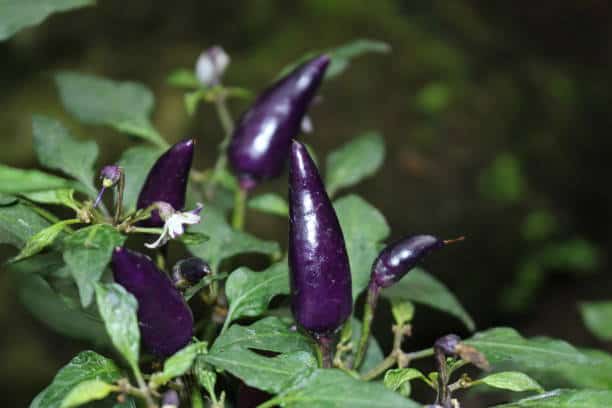
Purple tiger peppers are only about 1 inch in size and have a vibrant and eye-catching purple color. This type of pepper can completely be grown indoors for decoration because the purple color is extremely attractive to people. The foliage of this pepper has three vivid colors: creamy yellow, dark green, and purple at night.
In particular, with a mild spiciness, they are suitable for use as a seasoning in every meal like Jalapenos pepper. However, you need to pay attention to watering and drainage because this type of pepper is very susceptible to root rot due to waterlogging.
Explosive Ember (30,000 to 50,000 SHU – Hot)

Explosive Ember is also one of the peppers that have an upward fruit and are often used as an ornamental pot for indoor decoration. Because the pepper plant is small, it grows in a cone and the fruit is only about 1 inch in size.
This type of pepper has a significant change in color from seedling to maturity. Young peppers start as dark purple, dark or black, then they turn orange and blood red as they ripen. In particular, the purple flowers of the pepper plant are popular with pollinators. So you can use Explosive ember pepper to encourage insects to pollinate and increase the yield of your garden.
Fresno Peppers (2,500 to 10,000 SHU – Mild Heat)
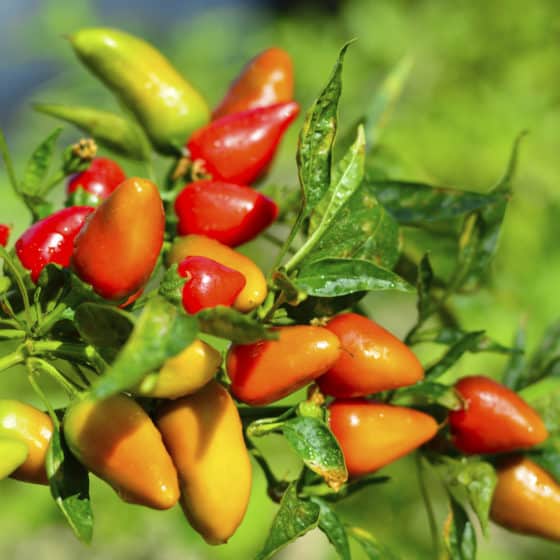
Fresno peppers are also an eye-catching pepper that many people love to decorate their homes with. They are green when young, then they turn orange and red when ripe. When the fruits are young they will grow upwards and then downwards as the fruit size gets larger. The spiciness of Fresno pepper is similar to Jalapenos pepper, so many people choose this pepper to use as an indispensable spice in every meal.
Prairie Fire Peppers (70,000 to 80,000 SHU – Very Hot)
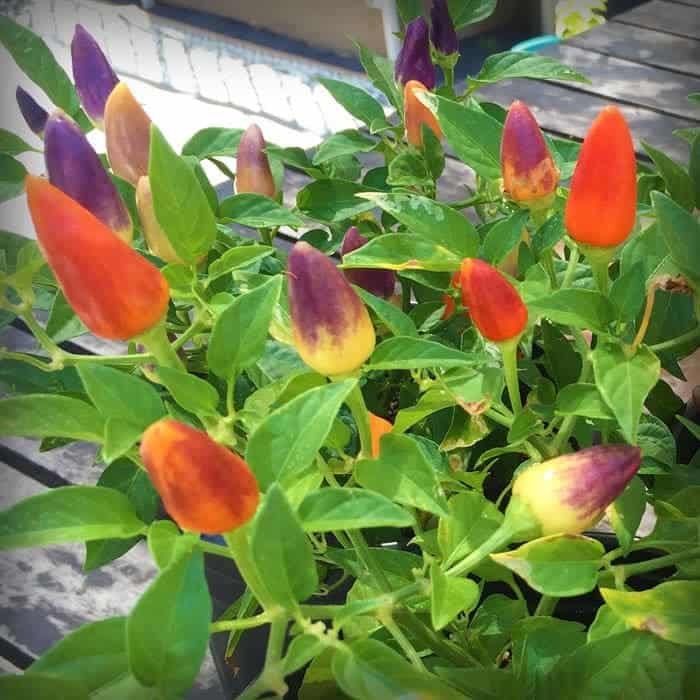
Prairie Fire Peppers have an extremely attractive appearance with a change of colors such as white, purple, yellow, orange, and red. This type of pepper is very suitable for ornamental planting and as a border for flowers. The size of the chili is about 1 inch with a very spicy flavor. However, in addition to being spicy, they have a mild sweetness that many people love to consume.
Masquerade Peppers (70,000 SHU – Very Hot)

Masquerade peppers are also another type of pepper that many people grow to decorate their homes. The chili has a delicious taste and is very spicy. The average spiciness is 8 times more than Jalapenos pepper. The color of the peppers will change from green, orange, red, and purple when ripe. You can harvest the peppers 70 to 100 days after the pepper plants have germinated. There is a small note when growing this type of pepper that you need to provide adequate sunlight for the plants. Because Masquerade peppers will only grow and produce fruit with delicious flavor when there is enough sunlight every day.
Chinese 5-Color Peppers (30.00 to 50,000 SHU – Hot)
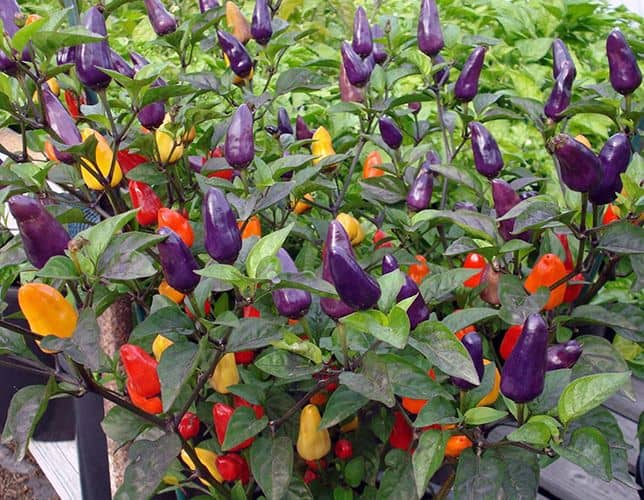
Chinese 5-color peppers are one of the favorite peppers to use in every meal because of their delicious taste. In particular, these peppers are only about 1 inch in size but can change up to 5 colors such as green, yellow, orange, red, and purple. Therefore, they are also one of the great choices to grow indoors and combine as a seasoning for everyday dishes.
Thai Hot Ornamental Peppers (50,000 to 100,000 SHU – Very Hot)
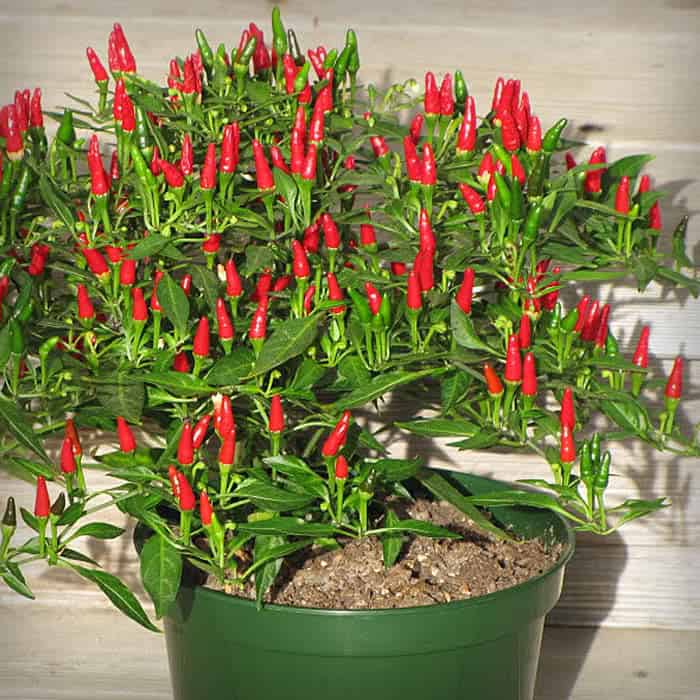
Thai hot ornamental peppers are famous for being 6 to 40 times spicier than Jalapeno pepper. The peppers will also be green when young, then turn yellow and red when ripe. They are about 1 inch in size and are one of the indispensable ingredients in salads or spicy sauces. This type of pepper can grow and develop best in hot and humid conditions. Therefore, it will not be suitable to grow in decorative pots for the home. Instead, you should plant them in the ground for a better yield.
Calico Peppers (50,000 to 70,000 SHU – Very Hot)

Many gardeners appreciate Calico peppers for their eye-catching appearance. The pepper plant has beautiful green foliage, and the leaves also have purple or cream spots everywhere. Therefore, these colors combine to create an extremely beautiful whole of Calico peppers. The peppers are also about 2 inches long and are purple when young, then turn bright red when ripe.
Conclusion
Pepper plants with fruit facing upwards are completely normal and you don’t need to worry about this. The peppers facing up are usually small and thin to avoid breaking branches or stems. Their spiciness is not affected by whether the pepper is facing up or down.
These types of pepper are often used as ornamental plants to decorate homes or offices. Because peppers and foliage come in a variety of colors such as green, purple, green, yellow, orange, and shades of red when ripe. In particular, they are often small in size, growing densely in the direction of the cone, so they are very suitable for growing in pots.
The upward-facing chili also has many advantages and disadvantages. Some advantages include ease of harvesting, decoration of the space, and attraction of insects for pollination. In addition, they also have some disadvantages such as broken branches, broken stems, or attractiveness to birds to consume. Because birds are completely unaffected by how hot peppers are, they can attack plants when they’re fruiting.